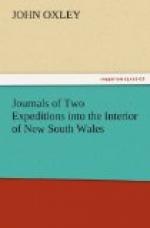September 3.—After passing over a fine and gently rising country for between four and five miles, we ascended a very lofty chain of hills, being the eastern boundary of Goulburn Vale; these hills were of good soil, and covered with excellent grass to their very summits. Ascending two of the highest ridges, several circular orifices were observed on them about twelve feet in diameter, and five feet deep. Great quantities of small stones resembling basaltes were in heaps round the edges, at a little distance from which the stones were perpendicular, and firmly bedded in the earth; many of them regular six-sided figures, and all fractured into laminae, from two to nine inches in thickness. The rocks upon this range were of a peculiarly hard quality, and of a deep blue colour, approaching to black when broken. The country easterly appeared broken into a series of rocky detached hills: and on descending this range, we found an immediate change in the quality of the soil, being in the valleys of a light coarse sand, the surface covered with gritty particles as from pulverised coarse granite. The difference in the rocks composing the hills was here very remarkable, being a very coarse granite of the same description as in the neighbourhood of Bathurst, scattered in immense masses both in the valleys and on the hills; and our astonishment was more than once excited at the causes which could have effected their removal from their primitive bed. On a hill near which we encamped, was a single mass of granite apparently thrown up perpendicularly from the bosom of the earth: it was twenty-six feet high and had six distinct sides, ending in an irregular point at the summit, and was forty-eight feet in circumference. The valleys, though sandy, afforded us plenty of good grass and water, and the hills furnished abundant employment for the botanical collector.




